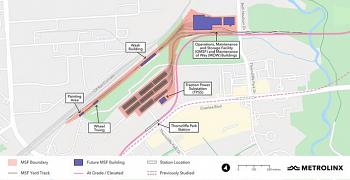Metrolinx selects East York site for Ontario Line maintenance and storage facility
Metrolinx has selected a 175,000-square-meter (18,83,684-square-feet) site for the Ontario Line’s train maintenance and storage facility following several months of study and assessment.
This critical component of the new subway will be built on a site east of Laird Drive, between Overlea Boulevard and Wicksteed Avenue. It’s where Ontario Line trains will be stored when they’re not carrying people across the city and where they’ll be inspected, cleaned and maintained so that they’re ready to take riders to their destinations.
“Confirming the location of the maintenance and storage facility is an important step in bringing the vision for the Ontario Line to life,” said Metrolinx project sponsor Malcolm MacKay. “When the facility goes into service, the work that happens there will help us give customers rapid transit that is safe, clean and reliable.”
Just like any other public transit operation, the maintenance and storage facility will be a vital organ for the Ontario Line. An estimated 200 train cars will be needed to meet Toronto’s needs when the Ontario Line opens, and the fleet will grow by as many as 50 more vehicles to meet demand for service in the future.
“Unfortunately, this amount of vacant land just doesn’t exist in the city,” said MacKay. “We want to protect jobs and businesses as best we can, so we looked at a number of different options and weighed all of the potential impacts. We feel confident that the decision we’ve made comes with the least amount of impacts to the community while still providing an essential piece of Ontario Line infrastructure.”
After exploring nine potential locations for the facility, the site in the southeast portion of the Leaside Business Park was selected because studies showed that it keeps impacts to the local community to a minimum while meeting all the needs for the project, including proper zoning for industrial use. Planning teams studied how quickly and easily each site would connect to the main Ontario Line tracks, the ability to expand to meet Toronto’s future transit needs, and how impacts on residents, businesses, and the surrounding environment could be minimized – both during construction and after the maintenance facility goes into service.
Metrolinx says minimizing impacts to businesses, employees and residents is a guiding principle, along with bringing major transit improvements to underserved neighborhoods.
Laboring over design decisions and keeping construction and building footprints as slim as possible is one of the ways Metrolinx does this. With a dedicated property team, Metrolinx also works with property owners and tenants to support their relocation, if needed. Decisions and strategies differ from property to property, and each case is considered independently.
“We care about the communities we serve and we know how important local businesses are to them,” said Jason Ryan, vice president of pre-construction services for Metrolinx. “Given the difficulties many of them have been facing recently, we’ll be challenging ourselves to go the extra mile to come up with creative solutions – a suite of customized supports to help them adjust, and hopefully relocate nearby if they wish.”
In all cases, Metrolinx works directly with any owner whose property needs to be acquired to understand their needs and to reach amicable purchase agreements that provide them with fair market value.
“We recognize that each business is different, and we’ll be doing all that we can to provide tailored supports that will ensure they can continue to thrive,” said Ryan.
Members of the community are invited to ask questions and share their feedback on plans for the Ontario Line Maintenance and Storage Facility in an upcoming virtual open house being held on April 15. Participants can register in advance online. For those unable to attend the live event, there will be an opportunity to submit questions ahead of time. This virtual open house, the first of many to come for neighborhoods along the Ontario Line alignment this spring, will specifically cover topics and questions related to area surrounding the maintenance and storage facility and the areas of Thorncliffe Park and Flemingdon Park.
“Community feedback is vital in helping us continue to move the project forward in the best way possible and to help us know how we can help you throughout the course of the project,” said MacKay.





